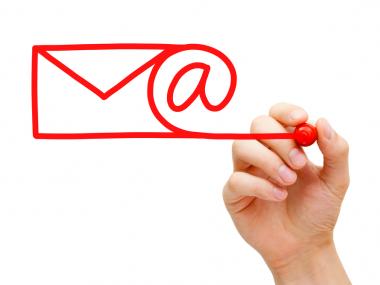Managing Email When Your Inbox is Overloaded
Managing email is getting harder and harder as the volume of messages keeps increasing, but our brainpower isn’t. The secret isn’t technological; it’s knowing how your brain works. Get-It-Done Guy has 6 tips to control inbox overload.
Managing email continues to bog us down. Get-It-Done Guy listeners write to me regularly, asking how to handle too much email. Today I’ll be sharing my 6 best tips on how to keep your inbox under control.
First, pretend I have long gray hair, a mighty oaken staff, and years and years of email wisdom. for I’ve been using email longer than you. How long? That’s such an impolite question. Let’s just say that if you think domain names belong in email addresses, you’re a late-comer to this particular party.
So I’ve been through all the how-do-I-manage-email learning curves: how to manage emotion in email, how to manage too much email and stay sane, how to cover your butt with innocent-seeming status updates instead of obnoxious BCCs. We’ll tactfully skip over the part where I learned about never, ever sending cyber-romance emails, and the fact that someone, somewhere, always saves a copy of every message you’ve ever sent. That’s fodder for my memoir and I want Zac Ephron (are you listening, Zac?) to play the part of Stever in the movie version.
So here are my 6 tricks to wrangle your email inbox into submission and keep it from taking over your life:
Tip #1: Manage Your Inbox, Don’t Empty It
In my 2008 episode on Keeping Your Inbox Empty, I shared a great tip for handling email by using a pencil and paper. It’s a great technique, works extremely well, and I use it daily.
But that was 4 years ago. Today, there’s simply too much email. If you handle every message that comes in, you can be sure you’re wasting a lot of time because much of that email isn’t relevant to your priorities. Spending time and attention on low-priority emails knocks you off your game at the moment.
Tip #2: Manage Email by Leaving it Alone
Get comfortable leaving email in your inbox without handling it. It will happen. If a non-empty inbox stresses you out, you’re setting yourself up for an early heart attack. There are enough real life things to get stressed about. Email doesn’t deserve that much emotional investment.
If something is really important, you’ll remember it without needing to deal with it at the moment. Or you’ll have written it down and added to your task list. And if you miss something important, someone somewhere will eventually remind you of it. Trust me on this one. The IRS is not going to skip auditing you just because you didn’t respond to their email. I know this from personal experience.
Tip #3: Turn Off All Notifications

Gmail recently started offering to notify me of new email on my desktop. I said no. You should, too. Do not believe that Google is trying to help you manage your email. Google is not. Google is trying to get you to look at ads, because that is how Google makes money. Google makes money by interrupting you, decreasing your productivity, and getting you to make impulse purchases that run up your credit card bills. They are not your friend; you are their product. Remember that.
Tip #4: Handle Email at Defined Times Only
If your email program doesn’t drive your attention, who does? You! Yes, this is your big chance to shine. Shut your email program when you’re done managing your email. Designate 2 or 3 times a day when you will commit to handling email. At those times, and only at those times, fire up your email program, process your inbox, and then shut it down.
I know what you’re about to say: “But my boss expects me to handle every email instantly.” Then talk to your boss. Say, “Boss, I want to be productive so our team hits our goals and you get promoted to a lovely corner office with a mahogany desk (far, far away from here). I’ll check my email daily at 10am, 1pm, and 3:30pm so I can focus in between.” Your boss will praise your innovative solution to producing high-quality work. Or your boss will explain that you should be able to work and handle every email that comes in. In that case, you’re in a no-win situation. You can find a new boss, or stop complaining and start meditating, because you’re stuck with the status quo unless you change it.
See also: How to Manage Your Boss
Tip #5: Manage Your Email With Only a Few Rules and Folders
The software makers tell you that you can set up rules to filter, sort, and manage your email. Over the many years I’ve been doing this, I’ve tried every automated solution under the sun and concluded that the effort of trying to make the system work is almost always more than the effort it saves me.
I manage my email using only a few folders: my inbox is where stuff comes in. Reference is where I file information that may be useful for a long time. Follow-up are messages that I’ll need to handle a current to-do item on my task list. And Archive, is where messages get put when they’ve been handled. Searching is the way to find old messages. I use my previous tip on managing messages when they have useless subject lines to make sure the message will be found when I search for relevant keywords.
Tip #6: Use a Special Email for Clients

I have many other email management tips, but this is all we have time for today. You can find them in my book Get-it-Done Guy’s 9 Steps to Work Less and Do More and in my audio program You Are Not Your Inbox.
This is Stever Robbins. I help people deal with overload by setting boundaries, creating better systems, and managing their emotions. If you want to know more, visit SteverRobbins.
Work Less, Do More, and have a Great Life!
RESOURCES:
? Episode on Keeping Your Inbox Empty
? Episode on Adding Keywords to Messages Before Filing Them
Cartoon with Laptop, Woman Checking Email on Phone and Woman at Cafe images from Shutterstock
You May Also Like…






